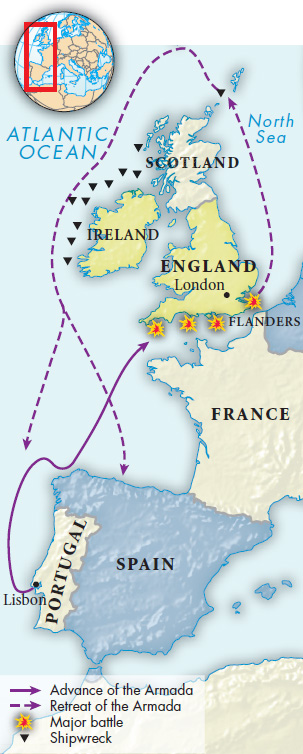A History of Western Society: Printed Page 409
A History of Western Society, Value Edition: Printed Page 419
Upholding Protestantism in England
In the short reign of Henry’s sickly son, Edward VI (r. 1547–1553), Protestant ideas exerted a significant influence on the religious life of the country. Archbishop Thomas Cranmer simplified the liturgy, invited Protestant theologians to England, and prepared the first Book of Common Prayer (1549), which was later approved by Parliament. In stately and dignified English, the Book of Common Prayer included the order for all services and prayers of the Church of England.
The equally brief reign of Mary Tudor (r. 1553–1558) witnessed a sharp move back to Catholicism. The devoutly Catholic daughter of Catherine of Aragon, Mary rescinded the Reformation legislation of her father’s reign and restored Roman Catholicism. Mary’s marriage to her cousin Philip II of Spain (r. 1556–1598), son of the emperor Charles V, proved highly unpopular in England, and her execution of several hundred Protestants further alienated her subjects. During her reign, about a thousand Protestants fled to the continent. Mary’s death raised to the throne her half-sister Elizabeth, Henry’s daughter with Anne Boleyn, who had been raised a Protestant. Elizabeth’s reign from 1558 to 1603 inaugurated the beginnings of religious stability.
At the start of Elizabeth’s reign, sharp differences existed in England. On the one hand, Catholics wanted a Roman Catholic ruler. On the other hand, a vocal number of returning exiles wanted all Catholic elements in the Church of England eliminated. The latter, because they wanted to “purify” the church, were called “Puritans.”

Shrewdly, Elizabeth chose a middle course between Catholic and Puritan extremes. Working through Parliament, she ordered church and government officials to swear that she was supreme in matters of religion as well as politics, required her subjects to attend services in the Church of England or risk a fine, and called for frequent preaching of Protestant ideas. (See “Primary Source 13.3: Elizabethan Injunctions About Religion.”) She did not interfere with people’s privately held beliefs, however. As she put it, she did not “want to make windows into men’s souls.” The Anglican Church, as the Church of England was called, moved in a moderately Protestant direction. Services were conducted in English, monasteries were not re-established, and clergymen were allowed to marry. But the church remained hierarchical, with archbishops and bishops, and services continued to be elaborate, with the clergy in distinctive robes, in contrast to the simpler services favored by many continental Protestants.
Toward the end of the sixteenth century Elizabeth’s reign was threatened by European powers attempting to re-establish Catholicism. Philip II of Spain had hoped that his marriage to Mary Tudor would reunite England with Catholic Europe, but Mary’s death ended those plans. Another Mary — Mary, Queen of Scots (r. 1560–1567) — provided a new opportunity. Mary was Elizabeth’s cousin, but she was Catholic. Mary was next in line to the English throne, and Elizabeth imprisoned her because she worried — quite rightly — that Mary would become the center of Catholic plots to overthrow her. In 1587 Mary became implicated in a plot to assassinate Elizabeth, a conspiracy that had Philip II’s full backing. When the English executed Mary, the Catholic pope urged Philip to retaliate.
Philip prepared a vast fleet to sail from Lisbon to Flanders, where a large army of Spanish troops was stationed because of religious wars in the Netherlands (see page 419). The Spanish ships were to escort barges carrying some of the troops across the English Channel to attack England. On May 9, 1588, la felícissima armada — “the most fortunate fleet,” as it was ironically called in official documents — composed of more than 130 vessels, sailed from Lisbon harbor. The Spanish Armada met an English fleet in the Channel before it reached Flanders. The English ships were smaller, faster, and more maneuverable, and many of them had greater firing power than their Spanish counterparts. A combination of storms and squalls, spoiled food and rank water, inadequate Spanish ammunition, and, to a lesser extent, English fire ships that caused the Spanish to scatter gave England the victory. On the journey home many Spanish ships went down in the rough seas around Ireland; perhaps sixty-five ships managed to reach home ports.
The battle in the English Channel has frequently been described as one of the decisive battles in world history. In fact, it had mixed consequences. Spain soon rebuilt its navy, and after 1588 the quality of the Spanish fleet improved. The war between England and Spain dragged on for years. Yet the defeat of the Spanish Armada prevented Philip II from reimposing Catholicism on England by force. In England the victory contributed to a David and Goliath legend that enhanced English national sentiment.